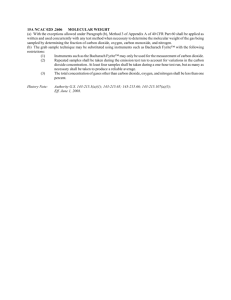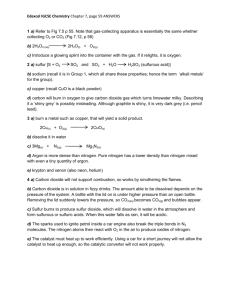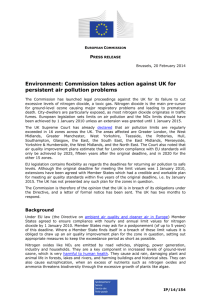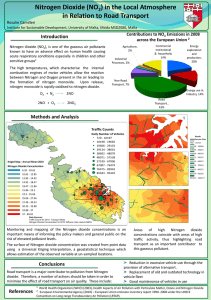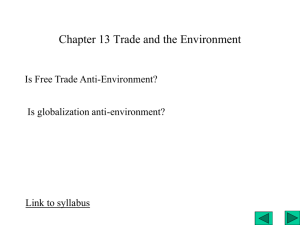Document 13359666
advertisement
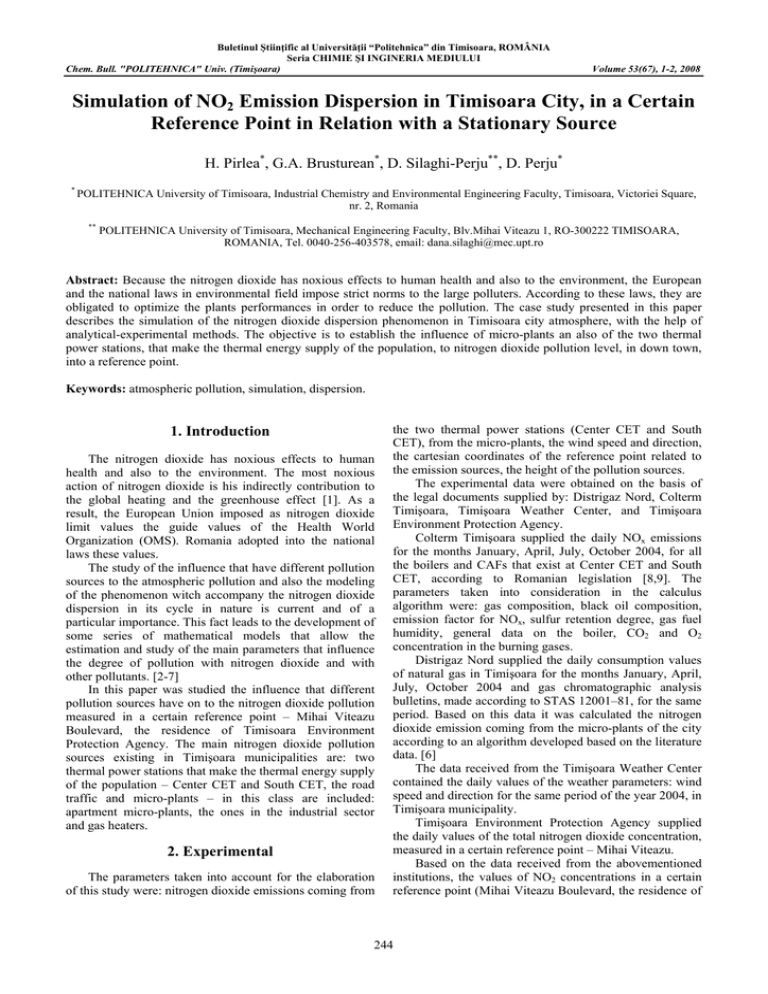
Buletinul Ştiinţific al Universităţii “Politehnica” din Timisoara, ROMÂNIA Seria CHIMIE ŞI INGINERIA MEDIULUI Chem. Bull. "POLITEHNICA" Univ. (Timişoara) Volume 53(67), 1-2, 2008 Simulation of NO2 Emission Dispersion in Timisoara City, in a Certain Reference Point in Relation with a Stationary Source H. Pirlea*, G.A. Brusturean*, D. Silaghi-Perju**, D. Perju* * POLITEHNICA University of Timisoara, Industrial Chemistry and Environmental Engineering Faculty, Timisoara, Victoriei Square, nr. 2, Romania ** POLITEHNICA University of Timisoara, Mechanical Engineering Faculty, Blv.Mihai Viteazu 1, RO-300222 TIMISOARA, ROMANIA, Tel. 0040-256-403578, email: dana.silaghi@mec.upt.ro Abstract: Because the nitrogen dioxide has noxious effects to human health and also to the environment, the European and the national laws in environmental field impose strict norms to the large polluters. According to these laws, they are obligated to optimize the plants performances in order to reduce the pollution. The case study presented in this paper describes the simulation of the nitrogen dioxide dispersion phenomenon in Timisoara city atmosphere, with the help of analytical-experimental methods. The objective is to establish the influence of micro-plants an also of the two thermal power stations, that make the thermal energy supply of the population, to nitrogen dioxide pollution level, in down town, into a reference point. Keywords: atmospheric pollution, simulation, dispersion. 1. Introduction The nitrogen dioxide has noxious effects to human health and also to the environment. The most noxious action of nitrogen dioxide is his indirectly contribution to the global heating and the greenhouse effect [1]. As a result, the European Union imposed as nitrogen dioxide limit values the guide values of the Health World Organization (OMS). Romania adopted into the national laws these values. The study of the influence that have different pollution sources to the atmospheric pollution and also the modeling of the phenomenon witch accompany the nitrogen dioxide dispersion in its cycle in nature is current and of a particular importance. This fact leads to the development of some series of mathematical models that allow the estimation and study of the main parameters that influence the degree of pollution with nitrogen dioxide and with other pollutants. [2-7] In this paper was studied the influence that different pollution sources have on to the nitrogen dioxide pollution measured in a certain reference point – Mihai Viteazu Boulevard, the residence of Timisoara Environment Protection Agency. The main nitrogen dioxide pollution sources existing in Timişoara municipalities are: two thermal power stations that make the thermal energy supply of the population – Center CET and South CET, the road traffic and micro-plants – in this class are included: apartment micro-plants, the ones in the industrial sector and gas heaters. 2. Experimental The parameters taken into account for the elaboration of this study were: nitrogen dioxide emissions coming from the two thermal power stations (Center CET and South CET), from the micro-plants, the wind speed and direction, the cartesian coordinates of the reference point related to the emission sources, the height of the pollution sources. The experimental data were obtained on the basis of the legal documents supplied by: Distrigaz Nord, Colterm Timişoara, Timişoara Weather Center, and Timişoara Environment Protection Agency. Colterm Timişoara supplied the daily NOx emissions for the months January, April, July, October 2004, for all the boilers and CAFs that exist at Center CET and South CET, according to Romanian legislation [8,9]. The parameters taken into consideration in the calculus algorithm were: gas composition, black oil composition, emission factor for NOx, sulfur retention degree, gas fuel humidity, general data on the boiler, CO2 and O2 concentration in the burning gases. Distrigaz Nord supplied the daily consumption values of natural gas in Timişoara for the months January, April, July, October 2004 and gas chromatographic analysis bulletins, made according to STAS 12001–81, for the same period. Based on this data it was calculated the nitrogen dioxide emission coming from the micro-plants of the city according to an algorithm developed based on the literature data. [6] The data received from the Timişoara Weather Center contained the daily values of the weather parameters: wind speed and direction for the same period of the year 2004, in Timişoara municipality. Timişoara Environment Protection Agency supplied the daily values of the total nitrogen dioxide concentration, measured in a certain reference point – Mihai Viteazu. Based on the data received from the abovementioned institutions, the values of NO2 concentrations in a certain reference point (Mihai Viteazu Boulevard, the residence of 244 Chem. Bull. "POLITEHNICA" Univ. (Timişoara) Volume 53(67), 1-2, 2008 Timisoara Environment Protection Agency) were obtained by analytical-experimental methods. In the end of the study, the influence of each pollution source to the total pollution in this point was establish. 3. Results and discussion In order to simplify the approach of this study the following simplifying hypotheses were formulated: • all micro-plants were considered as Hermann type, which is a medium class micro-plant, without filters and with a functioning efficiency of 90%; • because we don’t know the number and the distribution of the micro-station in the city, these were assimilated to 5 stationary sources. The location of the pollution sources and of the reference point in Timisoara municipality is presented in figure 1. Where: C(x, y, z) – pollutant’s concentration in point (x, y, z) [μg/m3]; u – wind speed [m/s]; Q – emitted debit of pollutant [g/s]; σy, σz - standard deviation of the concentration on the direction y and z, in the wind’s direction [m]; H – effective height from the ground level until at the center of the pollutant cloud [m] The calculus expressions of the standard deviations are presented in the relations 2, 3 and 4 [12]: (2) σ z = ax b σ y = 465 .11628 x(tan (Θ )) Θ = 0.017453293(c − d ln( x )) (3) (4) where: x – distance between the pollution source and reference point, [km] a,b – constants, whose value depends on x and on the atmospheric stability class. c,d – constants whose value depends on the atmospheric stability class. The effective height from the ground level until the center of the pollutant cloud is deduced with the help of the relation (5): H = h + Δh Figure 1. Location of the pollution sources and of the reference point 1 – north micro-plants; 2 – south micro-plants; 3 – east micro-plants; 4 – west micro-plants; 5- center micro-plants; 6 - Center C.E.T.; 7 – South C.E.T.; ● – reference point • Center CET and South CET have been considered two point-like sources though each has several emission chimneys. h – height of the chimney [m] Δh – height of the pollutant cloud [m]. The height of the pollutant cloud is deduced based on the algorithm presented in the diagram 2 [13]: In order to determine the x and y Cartesian coordinates of the stationary pollution sources in relation to the reference point, it was taken into account the wind direction in each day from the studied months. The z Cartesian coordinate of the reference point was considered equal to 3 m which coincides to the height at which the NO2 sensor was placed. Regarding the height of the pollution sources, in the case study the following values were considered: north micro-plants – 10 m, south microplants – 14,5 m, east micro-plants – 8 m, west micro-plants – 4 m, center micro-plants – 11,5 m, Center CET – 54,2 m, South CET– 160 m. In order to estimate in the reference point the nitrogen dioxide concentrations, resulting from each of the 7 stationary sources it was used the Gaussian dispersion formula [10,11]: ⎛ y2 Q C (x , y , z ) = exp⎜ − ⎜ 2σ 2 2πuσ yσ z y ⎝ (1) ⎞ ⎡ ⎛ ( z − H )2 ⎟ ⎢exp⎜ − ⎟⎢ ⎜ 2σ z2 ⎠⎣ ⎝ ⎞⎤ ⎛ ( z + H )2 ⎟ ⎥ + exp⎜ − ⎟ ⎜ 2σ z2 ⎠ ⎦⎥ ⎝ ⎞ ⎟ ⎟ ⎠ (5) Figure 2 Logical diagram with the calculus algorithm of height of the pollutant cloud The abovementioned calculus method was applied for each day from the four considered months: January, April, July and October. Using the daily values of the nitrogen dioxide concentrations in the reference point, resulted from the 7 stationary sources, were calculated the monthly averages. These values are presented in table 1. 245 Chem. Bull. "POLITEHNICA" Univ. (Timişoara) Volume 53(67), 1-2, 2008 TABLE 1. Nitrogen dioxide concentrations in the reference point, resulting from the 7 stationary sources January 1.023E+00 1.172E-02 1.833E-02 1.027E+00 1.447E+00 3.487E+00 4.552E-02 Total concentration from the stationary sources, into the reference point [μg/m3] 7.0588 April 7.223E-10 6.958E-02 2.883E-02 9.329E-02 4.999E-05 4.916E-01 1.064E-02 0.6940 July 1.748E-09 1.273E-02 1.791E-03 1.082E-01 5.387E-06 1.654E-03 5.342E-04 0.1249 October 5.506E-09 4.606E-01 2.654E-01 2.441E-01 7.641E-04 1.119E+00 0.000E+00 2.0899 Concentration from CET [μg/m3] Concentration from the micro-plants [μg/m3] Month North South East West Center Center CET The values of the nitrogen dioxide concentration generated from the 7 stationary sources, into the reference point, measured in the four months are presented in figure 3. (see table 1). South CET The weight of stationary nitrogen dioxide pollution sources 1% 20% 0% 38% 12% 3.5 29% 3 Concentratie, [ μg/m3] 2.5 the weight of north micro-plant the weight of south micro-plant the weight of east micro-plant the weight of west micro-plant the weight of center micro-plant the weight of Center CET the weight of South CET 2 1.5 Figure 4. The weight of stationary nitrogen dioxide pollution sources in relation to the total pollution from the reference point 1 0.5 ianuarie 0 aprilie nord sud iulie est vest centru Sursa octombrie iulie aprilie 4. Conclusions octombrie CET centru CET sud ianuarie Figure 3 Values of the nitrogen dioxide concentration result from the 7 stationary sources, into the reference point The nitrogen dioxide concentration resulted from the road traffic was obtained by the following algorithm: ⇒ we made the sum of the nitrogen concentration results from the stationary sources; ⇒ we subtracted this sum by the total nitrogen dioxide concentration measured in a certain reference point – Mihai Viteazu boulevard. The monthly average values of the total nitrogen dioxid concentration and also of the nitrogen dioxid concentration resulted from road traffic are presented in the table 2: TABLE 2. Total nitrogen dioxide concentration and the nitrogen dioxide concentration result from road traffic in the reference point Month January April July October Total nitrogen dioxide concentration in the reference point [μg/m3] 79.2810 45.1384 25.1249 35.4232 Nitrogen dioxide concentration result from road traffic [μg/m3] 72.2222 44.4444 25 33.3333 The nitrogen dioxide concentrations emanated in January from Center CET, are maximally. From all the stationary sources Center CET has the highest weight to the center town pollution. The micro-plants with the biggest influence on nitrogen dioxide pollution from the center of the city are the ones located in the north, west and center of the city. In April, from all the 7 pollution sources, the highest contributions fall on Center CET and West micro-plants. In July and October the stationary sources has an insignificant action on the nitrogen dioxide pollution in the center town. This is do to the elevated atmospheric temperatures from those months, witch means that the micro-plants weren’t used. Comparing the influence of the stationary and mobile sources on the pollution with nitrogen dioxide in the considered reference point, it was found that the mobile sources have an overwhelming weight in relation to the stationary ones (>90 %). In the reference point considered we found that the predominant nitrogen dioxide pollution source is the street traffic. It causes 90 – 95 % of the total nitrogen dioxide pollution from center town. REFERENCES The weight of stationary nitrogen dioxide pollution sources in relation to the total pollution from the reference point is presented in figure 4. 1. Glăvan S., Circulaţia rutieră şi protecţia mediului, Editura Mirton, Timisoara, 1999. 2. Savii G., Luchin M., Modelare şi simulare, Editura Eurostampa, Timişoara, 2000. 246 Chem. Bull. "POLITEHNICA" Univ. (Timişoara) Volume 53(67), 1-2, 2008 3. Pîrlea H., Rusnac C., Silaghi-Perju D., Perju D., RICCCE XIV, 22-24 septembrie 2005, Bucuresti , Vol. 3, Topic 5, , 2005, pp. 154-163. 4. Pîrlea H., Silaghi-Perju D., Perju D., Şuta M., 10th Mediterranean Congress on Chemical Engineering, 15-18 noiembrie 2005. 5. Pîrlea H., Silaghi Perju D., Peju D., Glevitzky M., Dobren F., Microcad 2006 International Scientific Conference, Environmental protection – Waste management, 16-17 March, Miskolc, Hungary, 2006, pp. 95-100. 6. Pîrlea H., Silaghi-Perju D., Perju D., Rusnac C., Revista de Chimie, 2006, 57(7), pp. 743-748. 7. Schnelle K. B.jr., Partha R. Dey, Atmospheric Dispersion Modeling Compliance Guide, McGraw-Hill, 1999. 8. Hotărârea de Guvern 541/2003. 9. Ordonanţa de Urgenţă a Guvernului 34/2002. 10. Air Quality Modeling in Environmental Impact Asessment http://www.ess.co.at/AIR-EIA/LECTURES/L001.html 11. Cheremisinoff N., Handbook of air pollution, prevention and control, PhD, N&P Limited, 2002. 12. EPA http://www.epa.gov/scram001/. 13. Milton R. Beychok (author and publisher), Fundamentals of stack gas dispersion, ISBN 0964458802, 4th Edition, 2005. 247


